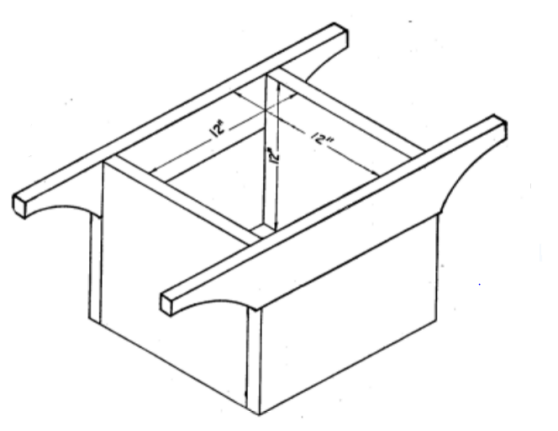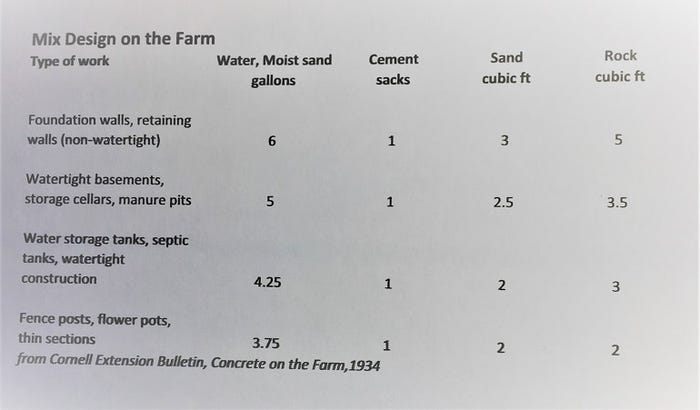In Part 3 of this series, concrete historian Luke Snell describes how farmers in the early 1900s would proportion the mixture to fit the application.

One of the good things about concrete is that you can custom make it for the project needs. If you need strong concrete, use more cement to achieve your goal. If strength is not critical, reduce the amount of cement which lowers the cost. Today when you order concrete from a batch plant, they weight all of the individual ingredients and deliver concrete to an exact mixture design. On the farm, weighting the materials needed to make concrete would be difficult, so the farmer used a simpler method: measuring the volume of the materials needed to make concrete.
This is still a time-proven method. A common concrete mixture is 1:2:3, that is 1 part cement, 2 parts sand, and 3 parts rock or gravel. In many parts of the world this method is still common. They load the mixer with shovels full of each material (1 shovel of cement, 2 shovels of sand, 3 shovels of rock) and add water until the concrete looks “right.” I have seen this method used in Algeria and Mongolia when they were site batching concrete. Although widely used, this method does not provide consistent concrete. Each person’s shovel amount may be different and when adding water, what looks right to each person can vary.
Although the 1:2:3 mixture is widely used, it may not be the best or cheapest concrete mixture for a project. Typically, the concrete used in a building foundation does not need to be as strong as the concrete for barn floors or roadways. To make more consistent concrete, farmers were encouraged to use a concrete mixture that had exact amounts of materials that met the needs of what they were building.
To ensure the quantities of materials were exact, the farmer would make a bottomless box of exactly 1, 2, or 3 cubic feet. Shown here is a one cubic foot bottomless box.

If the farmer was using a 1:2:3 mixture, he would fill the box 2 times with sand and 3 times with rock. After filling the box, the farmer would lift the box giving him an exact amount of sand and rock. The farmer would not need to measure the cement because it came in a 1 cubic foot bag that weighed 94 pounds. Many people wonder why modern cement bags have the odd weight of 94 pounds—now you know.
To make sure the farmer tailored the concrete to what was needed, he was encouraged to batch the concrete with the proportions shown in the table below.

The control of the water was the difficult part. If the concrete was too dry, it was difficult to place, if too wet the strength would be low. Since most sands have some moisture, the farmer had to determine how much water was in the sand. If sand was considered too wet, he would be instructed to reduce the amount of water. This was good advice however the final amount of water added to the concrete mixture was based on judgment and hopefully experience.
Some books gave the “water-cement ratio law” that had only been recently discovered. “For a given material and condition of handling, the strength of concrete is determined solely by the ratio of the volume of mixing water to the volume of cement so long as the mixture is plastic and workable.”
To drive home this fact, instructional books of the time further explained that if we use 7.5 gallons of water per sack of cement, the compressive strength of the concrete would be 1500 psi, 6 gallons per sack would be 2500 psi and 4.5 gallons of water per sack would give 3600 psi.(these strengths were measured at 28 days). This is excellent advice, however, the less water you put into the concrete, the more difficult it is to place and consolidate. Many times, the farmer would add more water than stated above just to make the job of placing the concrete just a little easier.
Today we have moisture meters that determine how much water is in the sand and computers that automatically adjusts the concrete mixture so there is a consistent amount of water in each batch. The farmer had to use a simple test to determine if the sand was dry, moist, or wet. He would take a handful of sand, squeeze it, then let it fall through their fingers. If it freely fell with no residue on the palm and fingers, the sand was dry. If it fell through the fingers but left a residue on the palm and fingers, it was moist. If after squeezing the sand, water ran out, the sand was wet.
The advice given in these self-help books for the farmer is still valid today.
We now produce a higher strength concrete; our durable concrete now exceeds 4000 psi and we add chemicals (admixtures) to keep the amount of water much lower that stated above.
If the farmer followed the advice provided in these self-help books, he had clean sand, good rock and a mixture design tailored to where he planned to place the concrete. Now comes the hard part. He had to mix the concrete, and that’s the subject of Part 4.
About the Author(s)
You May Also Like




